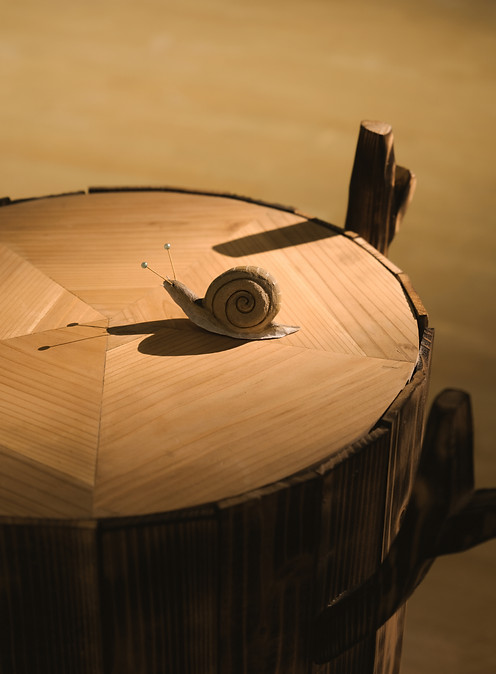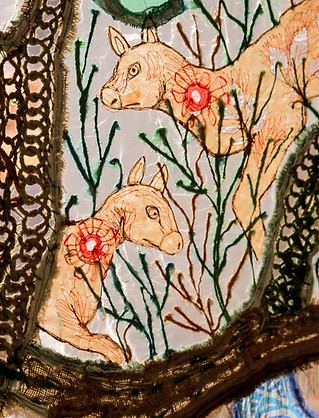
あざみ野コンテンポラリーvol.13 CLOTH×OVER 糸と布 日常と生を綴る
October 8th (Sat) - October 30th (Sun), 2022
主催 横浜市民ギャラリーあざみ野(公益財団法人横浜市芸術文化振興財団)
助成 芸術文化振興基金、公益財団法人野村財団
Azamino Contemporary vol.13 CLOTH×OVER Thread and Fabric-Writing the everyday and life
This exhibition will be held as the 13th installment of the ``Azamino Contemporary'' series of exhibitions, which focuses on the expressive activities of artists of various genres, without being bound by the framework of art or social evaluation.
In this series, we have focused on the reality of expressive activities and disseminated modern and challenging content as a facility open to the community.
This exhibition features up-and-coming artists who continue to create works using thread and cloth as materials through techniques such as sewing, weaving, embroidery, and dyeing: Kaoru Endo, Mariko Kobayashi, and Sora Yoo. I'll feature your work. Thread and cloth are materials that are closely related to people's lives, and many of them have developed and been passed down from generation to generation, rooted in the history and culture of the region, and are unique to each region. Because it is a material that has evolved with history, it also encompasses universality. Cloth is highly elastic and can be torn, cut, or sewn to change its shape, wrapping and covering the human body and objects, and has also functioned as a boundary between the inside and the outside. Cloth, which people often touch on a daily basis, evokes various memories and is deeply connected to the primitive sensations of pleasure and displeasure.
Using these familiar materials and techniques, this exhibition explores the subtleties of everyday life, the perspectives of labor and handicrafts, and the cycles of creation and extinction, creating a rich sense of everyday life woven from each artist's perspective. This is an introduction to the world of crossover expression.

全きものであった世界には、今や幾重もの境界線が引かれています。
生まれた時には皮膚という境界が「私とあなた」を、そして人間に
なる時には衣服という境界が「人間と動物」を、大人になる時には
秩 序という境界が「社会と自然」を隔てます。
生命を柔らかく包んでいた境界は、大人になるにつれ徐々に硬く分 厚い壁のようなものへと変化していくのです。 なぜ人間は拒絶とし
ての境界線を自ら進んで引いていき、硬い囲いの中へと進んでいく
のでしょうか。
けれども矛盾したことに、私がこの世界で最初に「美」を認知できた のは、その硬い囲いの中で柔らかな生命に出会ったからでもありま した。
人間の世界である「こちら側」に、動物の世界である「あちら側」か ら生き物がやってきて住み着いている風景は、境界のなかった全き ものとしての世界の記憶を呼び起こしたのです。
隔てられたもの同士が出会う交点、その境界に立つことは、私にと ってテキスタイルアートと対峙することと等価なものです。
なぜならテキスタイルは、人間が作りあげる境界の存在を視覚化し、 両者を拒絶するのではなく光を通して柔らかく” 繋ぐ ”ことのできる 皮膚のようなものだからです。
この 2 年間、人間が活動を停止していたことにより、多くの生き物が 押し込められていた境界を抜け出し、生命の光を闇から再生させつ つあります。
この展示では、世界に幾重にも引いてきた境界線を一つずつ無くし ていけるのか、ということについて考えるための空間を生み出せれば と思います。
小林万里子


The world, once all-encompassing, is now drawn with multiple borders.
At the moment of birth, the skin is the boundary that separates “you and I.”
When we become social beings, clothing separates “man and animal.” When we become adults, the order separates “society and nature.”
The boundaries, which used to gently embrace life, gradually transform into tough and thick walls as we grow older.
Why do humans draw boundaries to reject and voluntarily move into rugged enclosures?
Yet, contradictorily, it was within these enclosures where I first recognized the “beauty” of this world as I encountered gentle lives.
Creatures from “the other side,” the animal world, come and settle on “this side,” the human world. This scenery evokes memories of the world when it was unified without borders.
Standing at the intersection or on the borderline where two divided things meet is equivalent to working with textile art for me.
Textiles are like skin that can visualize the presence of human-made boundaries. It lets light through, softly “connecting” both sides rather than rejecting them.
As the activities of human beings were deactivated in the past two years, many creatures have started freeing themselves from the enclosures which had forcefully captured them. Now, the light of life is being generated from the darkness.
In this exhibition, I hope to create a space wherein we are able to consider whether we can eliminate, one by one, the boundaries layered on the world.
Mariko Kobayashi







社会科学者や一般の人々は例のごとく社会を織られたり編まれたりする
織物として述べる。しかし、社会の隠喩としての布、社会関係の隠喩と
しての糸は、結び付きだけでなくそれ以上のことを表現するのである。
これらの材質のもつ柔らかさと本源的な脆さは人間のどのような関係も
変わりやすいものであり、病気、 死亡、腐朽という退行過程に影響され
やすい人間のもつ弱さをとらえるのである。
( J・シュナイダー/A・B・ワイナー編『布と人間』)*1
動植物由来の繊維を原料とし、温かく柔らかい触感で人や物を 包み、保護する被膜としての布、人の手によって修復を繰り返しながら使い続けられてきた布――
本展は、おもに糸と布を表現媒体とした作品で構成される。
鑑賞者を最初に導く空間は、「闇からの再生」「生と死の反転」をテーマとする小林万里子によるものだ。小林は、一貫して生き物や生態系をモチーフとしてきた。作品中の生き物は、正確に観察描写されたものではない。それらは、生と死の連続体として地上に生きる生命のかたちを表したものといえるのではないだろうか。 小林の制作スタジオには、麻、オーガンジー、綿、羊毛をはじめ、自身で染織を手がけた素材など、多くの糸や布を種類別に収めた引き出しが並ぶ。作品としてのかたちを成す前の素材が溢れるスタジオは、静寂のなかに熱気が満ちている。
「木々の丸い隙間から空を見あげる。子どものころは、よくこうやって
何時間も空を見ていた。草や花を摘んで、それを揺らしながら空の下を
歩いた。(中略) その一歩一歩がステッチになって、布の上に刻みつけら
れていく。葉っぱや茎の形になって。わたしが、布のうえを歩いていた。」
(ほしおさなえ『恩寵』)*2
これは小説に登場する植物の刺繍に長けた主人公の言葉だが、 自然豊かな場所で過ごした子ども時代の原体験を語り*3、さまざまな素材を組み合わせて、身体のスケールを越える作品に取り組む小林の姿と、どこか重なるようだ。
小林は、動植物が輝く美しい世界を、いつかは消滅して自然に還ってゆく生命を、糸と布によって留めようとしているのかもしれない。
(横浜市民ギャラリーあざみ野 学芸員)


photo: Shusaku Yosikawa
